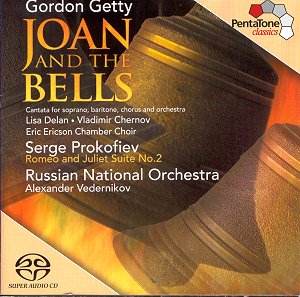When a composer is one of the richest men in
the world one naturally asks why his music is recorded. Did he
pay off the orchestra? Is this music utter trash that no one would
ever perform if they werenít bribed to do it? These are honest
questions, and they can be answered quickly. Joan and the Bells
is every bit as good as music written by composers who are starving
and homeless. We should not discriminate against the very rich
any more than against the very poor. And Getty is well known for
his very generous philanthropy in the musical arts, even to artists
and groups who donít play his music. For instance, he subsidised
the re-release on CD of a number of classic Bach organ recordings
by E. Power Biggs.
Joan and the Bells has been performed
recently a number of times, often in concert with Barberís Prayers
of Kirkegaard, but the world premier performance was with
the artists who here present it. It is an English text sung straight
through with no da capo arias. The vocal line is simply
made up of repeated notes and interval jumps, not greatly different
from the Alice series of Del Tredici, however the intervals
lie more comfortably within the range of the artists and the result
is less nervous and a little more tuneful. Soprano Lisa Delan
sings beautifully and with absorbing drama. Chernov has a slight
Russian accent, but he can be clearly understood, and the accent
sort of adds to the unapproachability of his role character. It
is, in fact, comfortable music throughout with a rising dramatic
tension, a brilliant sonic resolution and a genuine emotional
impact. I have heard it several times and look forward to hearing
it again.
Acknowledgement must be given to Paul Claudel
and Arthur Honegger in Jeanne DíArc au Bûcher (1955)
for the idea of the dialogues between Joan and her voices. In
that work the audience goes along with Joan to paradise and does
not see her earthly death. In this work, however, she dies onstage.
I have recently had the privilege of reviewing
several performances of Prokofievís complete Romeo and Juliet
ballet. It of interest to note that the Suites are drawn
from the original version, whereas the published complete version
is that which was re-orchestrated to suit hall acoustics. It is
a pity that the original version did not survive, because the
orchestration in the suites is more transparent and superior for
listening, if not for dancing. This performance is as good as
any Iíve heard; previously in my reviews I commented that Prokofiev
conceived his music so perfectly for the orchestra and expressed
his wishes so clearly that most performances are fully capable.
As Prokofievís music requires, the recorded sound here is superb.
This disk is a "hybrid" SACD which
means that it contains CD tracks, playable on an ordinary CD player,
as well as separate Stereo mix and Surround Sound mix SACD tracks,
playable both on older two track and newer multiple track SACD
players, on this single 5" disk at little or no additional
cost. Is there any real difference between the regular CD version
and the SACD version? Oh my yes, even to my 66 year old ears!
The sound is significantly cleaner and wider range on the SACD
tracks. Effective use is made of surround sound capability during
the oratorio, whereas the Prokofiev is presented in a natural
concert hall acoustic. In the SACD version the extreme percussion
is not exaggerated, but rather the opposite is true; these instruments
are recorded at a realistic moderate level yet are very clearly
audible. It is a genuine advantage to be able to buy this disk
and play it now on any CD player and then when you (or a friend)
obtain an SACD player, you can enjoy the superior sound quality
of the sound. And regular CDs will sound just a little bit better
on a new SACD player. The disk comes in a CD jewelcase with subtly
rounded corners but of ordinary proportions, so it will fit on
the shelf with your regular CDs.
Do we have to worry about getting so spoiled
with SACD sound we will be unable to enjoy regular CDs? Well,
donít you play music on the car radio on the drive home from a
concert hall? We have always had music available at various levels
of quality and should be used to concentrating on the music apart
from the sound. Itís just that now we can have a higher quality
of sound at home for those works which can benefit from it.
Paul Shoemaker
